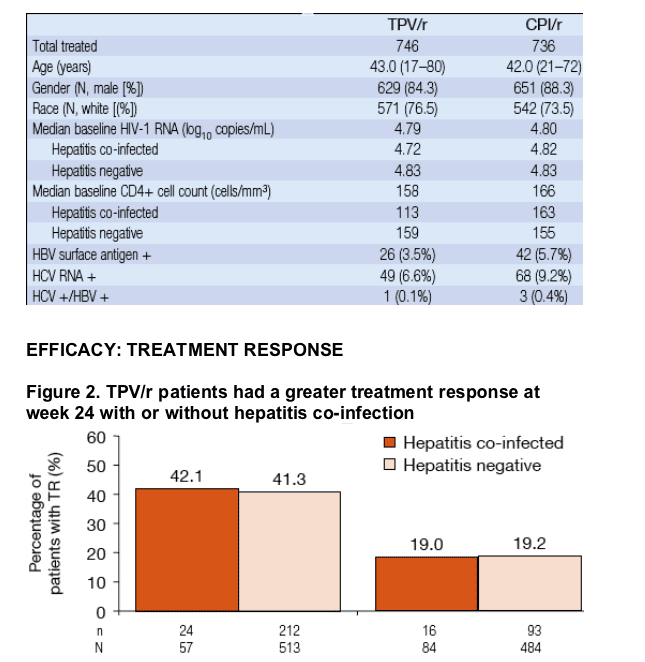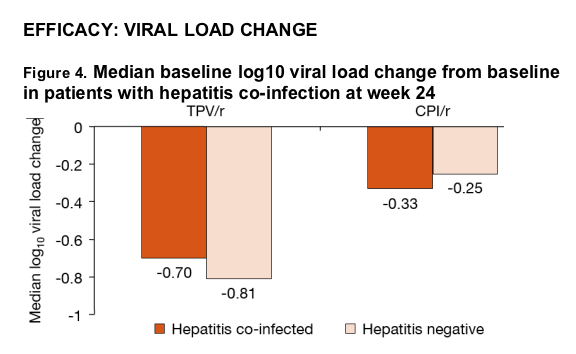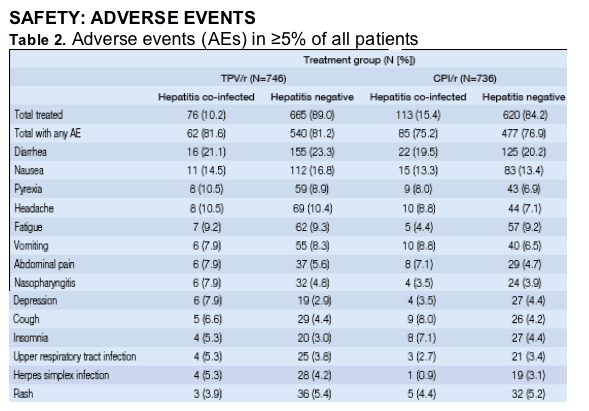 |
 |
 |
| |
Tipranavir Response by HCV/HBV Coinfected
|
| |
| |
Reported by Jules Levin
"RESIST 24-Week Efficacy and Safety of Tipranavir Boosted With Ritonavir (TPV/r) in Hepatitis B (HBV) or Hepatitis C (HCV) Co-Infected Patients"
Poster PE13.3/4
10th European AIDS Conference (EACS)
November 17–20, 2005
Dublin, Ireland
S Mauss1, J Stern2, M Elgadi2, M Drulak2, D Mayers2, M Kraft3
1Arzt fur Innere Medizin, Dususeldorf, Germany; 2Boehringer Ingelheim Pharmaceuticals, Ridgefield, CT;
3Boehringer Ingelheim GmbH, Ingelheim, Germany
Tipranavir (TPV) is a non-peptidic protease inhibitor (NPPI), with a resistance profile distinct from currently available PIs, that is now approved by the US Food and Drug Administration and the European Medicines Agency. The companion Phase III RESIST-1 and RESIST-2 trials demonstrated that TPV/r was superior to a standard-of-care boosted PI at 24 weeks.1,2 TPVbased therapy produces potent, durable, and tolerable therapy in PI-experienced HIV-1–infected patients.3,4 In a 4-year follow-up study of treatment-experienced patients, TPV/r therapy was generally well tolerated and adverse events were not associated with treatment discontinuation.5
Advances in antiretroviral therapy have improved the life expectancy of HIV+ patients; consequently, liver disease related to hepatitis B virus (HBV) and hepatitis C virus (HCV) co-infection has emerged as a significant co-morbid disease among co-infected patients. In addition, co-infection may increase the likelihood of AIDS-defining events. Since TPV and ritonavir are metabolized by the liver and a substantial proportion of co-infected patients have advanced fibrosis or compensated cirrhosis, the efficacy and safety of TPV/r was analyzed in a subgroup of patients with hepatitis co-infection in the RESIST trials. These updated results, compared with those from HIV+ singly infected patients, are presented here.
ABSTRACT
BACKGROUND:
The 2 Phase-III RESIST trials demonstrated the statistically superior efficacy of TPV/r over comparator ritonavirboosted protease inhibitors (CPI/r). This analysis compares these treatment regimens in those HIV+ patients who were co-infected with HBV (HBsAg+) and/or HCV (HCV RNA+).
METHODS:
Patients were randomized to receive TPV/r (500 mg/200 mg bid) or a preselected optimized CPI/r, plus an optimized background. Inclusion criteria required patients to have baseline laboratory test values and ALT/AST levels ≦ DAIDS grade 1. Treatment response (TR) was the primary endpoint.
Inclusion criteria included:
--Total cholesterol and triglycerides ≦ DAIDS grade 2
--ALT ≦3.0 x ULN and AST ≦2.5 x ULN (≦ DAIDS grade 1)
--Co-infected patients were only allowed to enroll if their screening
transaminases were ≦ 2.5-fold above the upper limit of normal
RESULTS:
1483 patients were randomized and treated, and 1159 patients (582 in the TPV/r arm and 577 in the CPI/r arm) were available for analysis at 24 weeks. In the TPV/r arm, 3.5% (26/746) were co-infected with HBV (HBs-antigen positive) and 6.6% (49/746) with HCV; 1 patient was HBV/HCV co-infected. There was no
significant difference in TR between HBV+ (34.8% [8/23]) and HBV- (41.4% [230/556]) patients. HCV+ TPV/r recipients had a TR of 47.1% (16/34) vs 40.9% (222/543) for HCV- patients. TPV/r had a superior TR to CPI/r for HBV+ (34.8% vs 11.8%) and HCV+ (47.1% vs 24.5%) patients. A larger percentage of viral
hepatitis co-infected TPV recipients achieved VL below detection compared with CPI/r recipients: 38.6% [22/57] vs 15.5% [13/84] achieved VL <400 copies/mL and 26.3% [15/57] vs 10.7% [9/84] a VL <50 copies/mL. In both arms, the incidence of grade 3/4 ALT/AST abnormalities was higher in both HBV
co-infected (TPV 17.4%/17.4%; CPI 5.0%/5.0%) and HCV co-infected (TPV 14.3%/10.2%; CPI 7.4%/5.9%) patients compared with HIV-only infected (TPV 8.4%/5.2%; CPI 1.5%/1.3%). TPV/r was generally well tolerated in this population.
CONCLUSION:
TPV/r treatment showed comparable efficacy in HIV+ patients with and without HBV and/or HCV co-infection. Most co-infected patients tolerated TPV/r and did not develop marked liver enzyme elevations.
BASELINE CHARACTERISTICS
Table 1. Baseline demographic data

The overall treatment response (≥1 log10 VL reduction) was 41.2% for TPV/r and 18.9% for CPI/r
Patients with HCV or HBV co-infection had a similar treatment response as compared with the overall patients and patients not co-infected
Patients taking TPV/r had a higher treatment response than patients in the CPI/r, regardless of hepatitis status

The virologic response of TPV/r patients was similar with and without hepatitis co-infection at <400 copies/mL (38.6% vs 33.9%) and <50 copies/mL (26.3% vs 23.8%)
TPV/r patients had a superior virologic response regardless of hepatitis co-infection status

TPV/r patients had a greater median viral load reduction than CPI/r, regardless of hepatitis co-infection status
The median viral load reduction of TPV/r was similar with and without hepatitis co-infection

The most reported AEs in the TPV/r group with hepatitis co-infection were diarrhea, nausea, pyrexia, headache, and fatigue
--These were also among most commonly reported AEs in the CPI/r hepatitis co-infected group
In the TPV/r arm, both the types and frequencies of AEs were comparable in hepatitis negative and hepatitis co-infected patients
No hepatic events occurred in ≥5% of either hepatitis negative or hepatitis co-infected TPV/r patients
--The frequency of hepatobiliary events were similar in hepatitis negative and hepatits co-infected patients

The incidence of grade 3/4 AST or ALT levels was higher in both arms patients with both HBV and HCV co-infection than in patients with only HIV infection
--These higher levels did not lead to symptomatic hepatic events
The participants in the TPV/r arm experienced a higher rate of liver enzyme and lipid elevations; however, most laboratory abnormalities were asymptomatic and most patients remained on treatment without permanent discontinuation
|
|
| |
| |
|
 |
 |
|
|